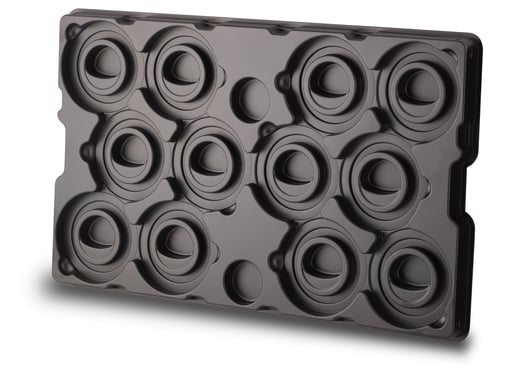Thermoformed dunnage trays protect, secure, and orient products during automated or manual part assembly, shipping, and storage. While each plastic dunnage tray is custom designed, there are shared design features. These include: Tray size/parts per tray; stack & rotate, denests, and hand access design features; automation; and material type and thickness.

Tray Size
Dunnage tray size is largely determined by the part size and desired number of parts per tray married with any pre-determined sizing constraints i.e., automation. When designing thermoformed dunnage trays, individual cavities are usually required to hold each part. Here, space between each cavity must be added, along with draft and a proper draw ratio to allow for consistent material distribution throughout the form.
Parts/Tray
The goal of many dunnage trays is to package the highest number of parts to optimize material handling and shipping operations. However, the function of the thermoformed tray to protect and secure the parts shouldn’t be compromised by this priority. In this vein, Dordan utilizes a template before quotation to calculate the number of parts per tray to achieve the desired tray size, or, determine the tray size based on the desired number of parts per tray. This output helps clients decide, based on their custom packaging requirements, what scenario of parts per tray vs. tray size is best.
Stack-and-Rotate/Denests/Hand Access
Plastic dunnage trays tend to have a stack and rotate feature, which means that the tray, when loaded with product, is rotated 180 degrees and stacked on top of the loaded tray directly beneath. This feature creates clearance between the top of the part and the bottom of the dunnage tray, adding superior product protection. When stacked and packed, further structure is provided, reducing the likelihood for damage in shipping.
Denests are formed features on the tray sidewalls that keep the stacked dunnage trays from getting stuck together. The size/design of denests are based on specific project requirements, but they all tend to be of similar overall construction.
Hand cut outs on thermoformed dunnage trays help when packing loaded trays into shipping cartons. These are simple indents on the tray perimeter that allow someone to easily carry and place in a carton.
Trays for Automation
If the thermoformed dunnage trays are intended for automated assembly operations, then there are common footprints based on the shared platform sizes for pick-and-place operations. However, it is recommended that dunnage trays for automation be designed before/alongside the assembly module to ensure a smooth integration between the trays and robotics.
Trays for automation require locating features that allow the equipment to sense where the dunnage tray is in the assembly module and where the parts are in the cavities. It is highly recommended that the tray flange not be used as the locating feature due to thermoforming die cutting tolerances (https://www.packagingdigest.com/robotics/how-robotically-handle-trays-parts-packaging). If the thermoformed dunnage tray is being integrated into existing automation, the locating features should be designed accordingly. If the trays are being developed with the automation, then thermoforming engineers can determine the best locating features to optimize tray and automation performance.
Material Type/ Thickness
The majority of thermoformed dunnage trays that Dordan manufactures are made from black RHIPS. However, dunnage trays can be made from any of the standard plastic materials. If the plastic trays have to be clear, RPVC or RPET; if they require electro-static dissipative material, ESD RPET is required. RHIPS is ideal for dunnage trays because it has more rubber in it when compared to RPET/PVC, which means that there is more ‘give’ and less likelihood for cracking.
Material thickness is largely determined by the load that the thermoformed tray is to bear, the functional requirements of the tray, and the depth of the part. If the thermoformed dunnage tray is to hold multiple heavy parts, then the material thickness needs to be robust. If the part is very deep, then more material is needed to draw into the bottom of the cavities. It is always a compromise between material thickness/functionality and cost. Dordan’s goal is to develop dunnage trays with the least material amount of material consumed, while meeting the functional requirements of our customers.

